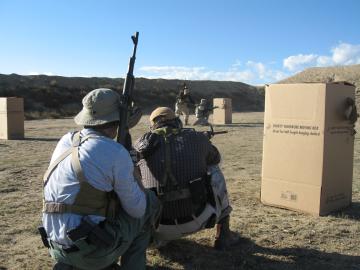Published in 2009 Book of the AK-47

 With ammunition costs still less than 5.56, the AK remains a popular
training platform, as shown in this photo from a Tactical Response
carbine class.
It's sometimes hard to look past the most common loading to see a
cartridge's full potential. The 7.62x39 mm is a good example of this
phenomenon. The ubiquitous military loadings of the 7.62x39 were
state of the art in the 1940's but have lackluster performance today.
In this article I'll show you three strengths of the 7.62x39 which are
largely ignored by its users: good performance in short-barreled
rifles (SBR); the use of modern and heavy projectiles which have near
ideal terminal performance; and heavy subsonic loads for suppressed
use.
The popularity of the 7.62x39 in the United States and the SKS and
AK-47-based sporting rifles is based primarily on the historic
rock-bottom prices of surplus 7.62x39 ammunition. Within the last
decade, cases of 7.62x39 could be had for less than $100; however,
today that price has risen by about 250 percent. Although it is
popular for simply blasting and plinking, the 7.62x39 has ballistic
value.
Two military loadings dominate 7.6x39 ammunition, both use FMJ
projectiles. The original M43 loading used a 123-grain boat-tail FMJ
bullet with a large steel core. Later, the Yugoslavians developed a
new bullet with a flatter base and no steel insert. These changes
were made to enhance terminal effects in tissue. Chinese military
ammunition in 7.62x39 has a steel core with no lead, and is currently
not available to import into the U.S. due to language of the AP
ammunition ban. Standard mil-spec 7.62x39 ammunition has a muzzle
velocity of 2329 fps with the 123-grain projectile.

 The AK design is tolerant: factory, surplus, and a variety
of handloaded ammunition runs fine through this Krebs Custom rifle.
Ballistics experts such as Dr. Gary K. Roberts (LCDR, USNR) have
defined what "ideal" terminal effects look like from a quantitative
standpoint. As a bullet enters a uniform tissue medium, it creates a
wound channel. This channel is conceptually split up into several
sections. As the bullet enters it continues straight and stabilized
for some distance. This is called the initial upset depth, or the neck
length. In this region, the bullet creates essentially a hole more or
less the same diameter of the bullet itself. At the end of the neck,
the bullet starts to yaw, expand, or fragment and it creates a larger
wound channel. This large wound cavity is defined by its length,
height, and width and this is where the most tissue damage occurs as
the bullet fragments split up and cause a lot of damage. At the end
of this maximum damage cavity, the largest bullet fragment or
fragments will continue creating a wound channel until they stop in
the medium. This is the total depth of penetration.
Overall, the bullet pokes in the medium the "neck length" distance,
then it expands, fragments, and yaws to create usually a football or
fan-shaped large internal wound, and then the largest fragments
continue penetrating to the maximum penetration depth. Ideally, the
initial upset depth is one inch or less; up to three inches is
acceptable. The length of the maximum damage cavity should be as long
as possible in the first 12 inches of penetration, and the cavity
height and width should be as large as possible to ensure maximum
damage. Finally, the total depth of the penetration should be between
12 and 18 inches.
|